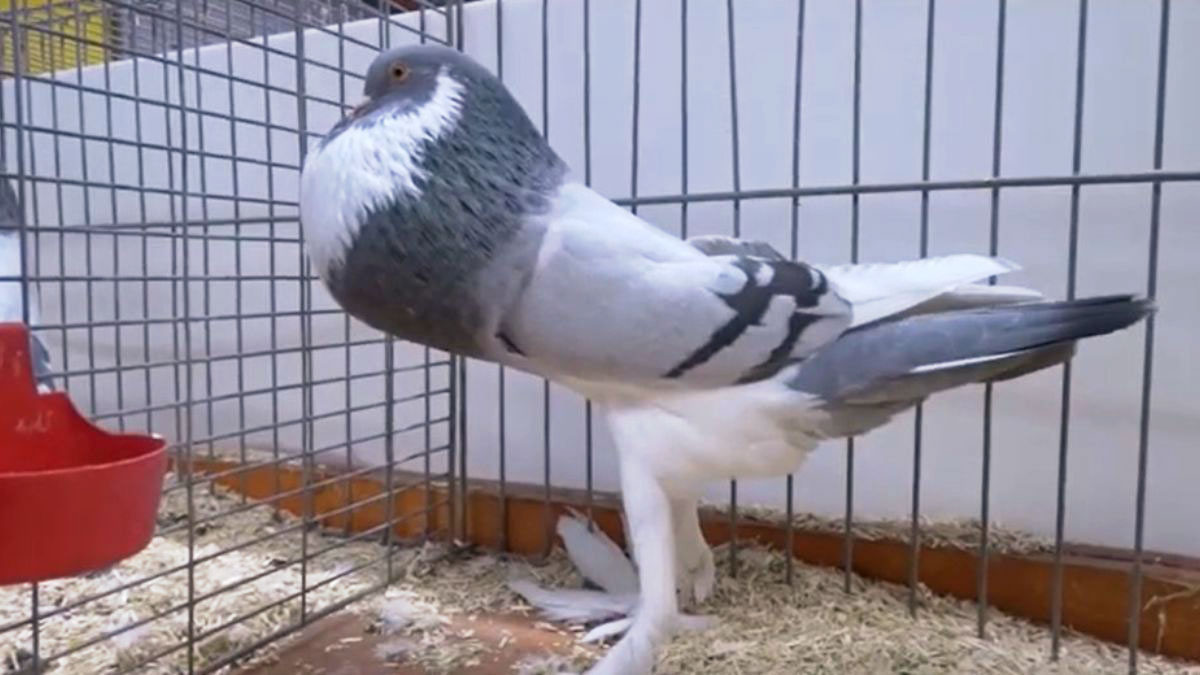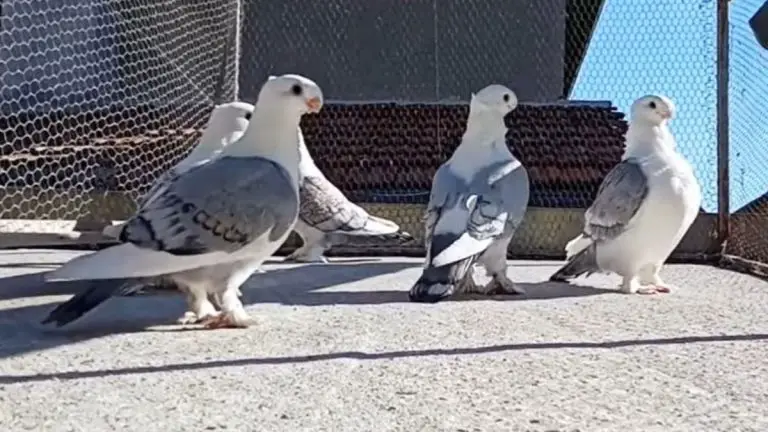English Pouter Pigeon: Origin, Appearance, Behavior, Care, And More
The English pouter pigeons are classified as one of the most unusual breeds of pigeons available. This is due to their unique ability to puff up their chest to pretty big sizes and hold them in that position for prolonged periods of time. That’s something you’d want to watch all day!
This article will take you through everything you need to know about the English pouter pigeon including the bird’s history and origin, physical appearance, behavioral traits, life expectancy, suitability as a pet, and so much more.
English Pouter Pigeon Quick Facts:
| Scientific name | Columba livia domestica |
| Other names | None |
| Breed name | English Pouter |
| Origin | United Kingdom |
| Breed purpose | Exhibition, pets |
| Size | Medium to large |
| Flying ability | Good |
| Cost | $50 to $500 |
| Lifespan | 10 to 15 years |
Origin and history
The history of the English Pouter is unclear but it’s believed to be from the United Kingdom. It may have originated in England over 400 years ago.
According to William Bernhardt Tegetmeier, this bird may have been developed by crossing old breeds of pigeons namely Uploper, Dutch cropper, and Parisian cropper. All these breeds have existed since the 17th century. (Source).
However, another account by John Moore suggests that this breed was produced by crossing a cropper variety and a horseman (both breeds existed from 18th century).
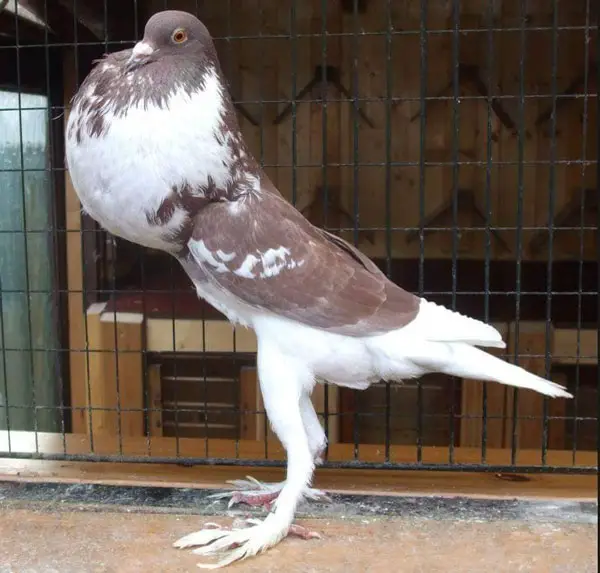
This makes sense because the English pouter was also referred to as Pouting Horseman as it was linked to the Horseman pigeon breed.
Mind you, modern cropper breeds such as the Norwich cropper pigeon, are believed to have originated from the English Pouter.
Charles Darwin commented on the unique crop appearance of this bird in his 1868 book titled The Variation of Animals and Plants Under Domestication.
This is exactly what he said: “perhaps the most distinct of all domesticated pigeons” (Source).
This unusual fancy pigeon breed was also developed following years of selective breeding and is the domesticated form of wild rock dove (Columba livia).
Interestingly, the raised, full breast of this pigeon breed influenced the women’s dresses known as pouter pigeons which were puffed right above the waist and were the trend around the first decade of 20th century.
Appearance
English pouter is a tall pigeon breed characterized by a large, well-rounded, and puffed-up crop. The bird naturally assumes a standing-like stance which makes it look magnificent.
When standing, its eye should fall over the ball of its foot.
The pigeon’s head looks similar to that of a dove and is generally small in proportion to its body. It has a pretty long waist (believed to be around 1/3 of the bird’s total length), is V-shaped, and is narrow.
It also has quite long legs (it’s the tallest of all pouter breed varieties), with most of the length being from the knee to the feet. Overall, the bird has an average body height of around 16 inches.
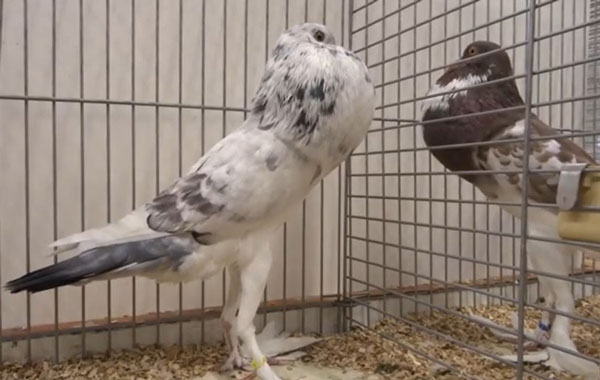
The legs are usually clad in smooth feathers appear strong and step high as the bird walks. The crop, or globe as most fanciers like referring to it, appears large and well-rounded.
It also appears well inflated and springy from its waist sharply.
Wings are packed close to the bird’s body while appearing narrow and carried quite high.
Like most domesticated pigeon breeds, this pigeon is also available in a variety of colors.
The most common color varieties include grey, black, black check, blue, blue check, white, silver, dun, and yellow.
Behavior
English pouter pigeons are known for their calm and gentle temperament, a characteristic that makes them suitable for keeping as pets (more details coming up).
They’re also friendly and affectionate birds which makes them easy to handle/tame and fun to keep.
The birds are not aggressive towards humans or fellow birds and can actually be kept together with other pigeon breeds.

They’re perfect at inflating their crops, a behavior that males would do to interest females to mate with them.
However, this also plays a crucial role in exhibitions. Fancies would actually encourage their birds to do it to help display their strutting and/or posing skills.
Diet
Proper diet for English pouter pigeons includes a mixture of seeds, grains, and legumes.
Luckily, you can get high-quality commercial pellets that include these ingredients mixed up correctly to provide your bird with all the essential nutrients. Or you can simply do the mix-up on your own.
Additionally, we recommend feeding the pigeons fresh vegetables and fruits to help add variety to their diet as well as ensure they have all the necessary nutrients.
Quality grit is also essential for pigeons as it aids in proper digestion while allowing them to absorb necessary minerals.
Clean and fresh water should also be part of your pigeon’s everyday diet to help keep it hydrated at all times.
English pouter as pets
You can keep English pouter pigeons. However, knowing how to take good care of them will help you raise high-quality and healthy birds.
You should ensure you provide your bird with a suitable living space. The perfect pouter pigeon loft should be spacious to allow them to freely move around and fly to exercise.
It should also be well-ventilated and protected from predators and harsh elements. And should be kept clean at all times.
Proper nutrition is another important step in taking good care of your pigeon. Make sure you provide it with the right type of food.

Feed it twice every day, and amount it can deplete in about 20 minutes. Don’t leave any leftover food in the loft as it can attract mold and bacteria.
Quality grit and clean water are also essential for the survival of your bird.
Since these birds are sociable and friendly in nature, spending more time with them will help in bonding with them. This also helps make them tamer. Handfeeding the squabs from a young age makes the taming process even easier.
On top of it all, be sure to give your birds routine checkups by a vet who is experienced with pigeons. This ensures your birds stay healthy. It also helps catch health issues in the early stages before they develop into serious complications.
We found this interesting video of Pouter pigeons going about their business in a loft filled with other pigeon breeds.
Video:
Breeding pouter pigeon
The breeding part for English pouter is pretty easy as these pigeons are naturally good breeders.
However, if you’re starting a breeding program or raising show-quality birds, then you should be more careful with the pairings to ensure you produce high-quality offspring with desired traits.
Choose healthy, high-quality parents that have desired physical traits like well-rounded crops while being free of genetic defects and in good health.
During nesting, you should provide each air with suitable nesting where they can lay and incubate eggs comfortably. Lining the box with soft materials such as wood shavings or straws is recommended.
The eggs generally take around 18 days to hatch. And during this time, you ought to provide your birds with a balanced diet and plenty of clean and fresh water.
You should also keep the nesting area clean to keep away potential health issues.
Even better, these pigeons are good parents and will feed and rear their young ones after they hatch.
They’ll do so for a period of pouter pigeon baby growth of about 4-6 weeks, after which the baby pigeons can be separated and start living on their own.
Here’s a rare clip of a pouter pigeon tending to its young one.
Video:
Pouter pigeon price
The English pouter pigeon price ranges from $50 to $500.
Pouter pigeons featuring desirable traits for shows/exhibitions such as colorations, patterns, or those that come from a proven pedigree usually cost higher.
Pet-standard pigeons, on the other hand, are much more affordable.
Other key factors influencing the price of this bird include the bird’s age, location, breeder, etc.
Lifespan
The average lifespan of English pouter pigeons is around 10 years, though some birds may live for much longer than this. The secret to enhancing the lifespan of your pigeon is giving it proper care.
This includes providing the bird with a proper diet, a hygienic and comfortable living environment, and encouraging regular exercise.
Regular vet checkups also help keep the bird’s health in check and prevent health issues that could affect the bird’s longevity.
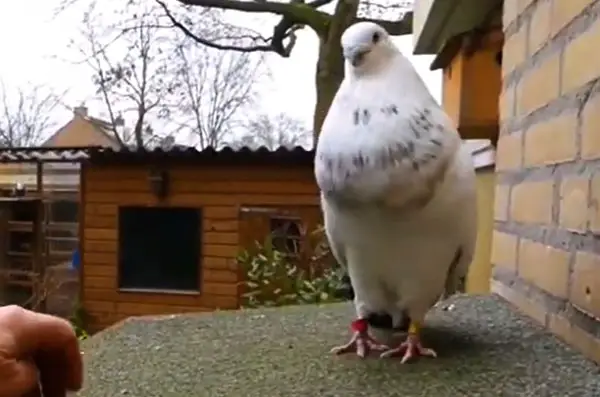
FAQs:
The pouter pigeons are usually kept as fancy or ornamental birds for show and exhibition purposes. They’re valued due to their unusual appearance which involves a large, puffed-up crop.
The English Pouter pigeons can fly for fun but not as good as some breeds of pigeons. This is due to their large crop which can make it challenging for them to fly over long distances or for prolonged hours.
Pouters and croppers simply mean the same thing and can be used interchangeably. They refer to the birds’ ability to inflate their crops.
However, a cropper usually has a straighter and shorter legs and its crop appears ball-like and isn’t set too far from its body compared to a pouter.
Final Verdict
The English pouter pigeon is one of the most fascinating and unusual pigeon breeds known today. Its distinctive features such as a large and well-rounded crop and an erect posture make it stand out from other birds. These features make it a highly prized bird in pigeon shows and exhibitions.
Calm temperament and friendly nature also make it good for raising as a pet. But you’ll need to meet the bird’s special requirements to ensure it stays happy and healthy for years to come. Follow our care tips and advice in the above guide to ensure you raise high-quality and healthy English pouter pigeons!
